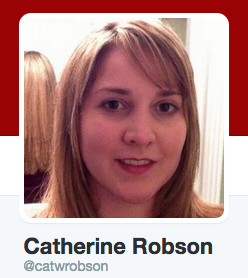 Cat Robson is a user experience strategist and manager working on the Red Hat user experience team. Since arriving at Red Hat in 2012, she has influenced the design of the JBoss Developer website, JBoss EAP, JBDS, and other products. She helps teams see how a user experience focus can improve the quality of their offerings. She teaches each part of the organization to become passionate about the user experience.
Cat Robson is a user experience strategist and manager working on the Red Hat user experience team. Since arriving at Red Hat in 2012, she has influenced the design of the JBoss Developer website, JBoss EAP, JBDS, and other products. She helps teams see how a user experience focus can improve the quality of their offerings. She teaches each part of the organization to become passionate about the user experience.
Read her blog about user experience at CatRobson.com.
Prior to her talk at DevNation this year, I reached out to her so we could learn more about her work at Red Hat and about the future of open source licenses in the Internet of Things (IoT) era.

What tools do you use as a UX professional?
There are a variety of tools that I use. I tend to try to find the best tool for the job at hand, and each project needs a different focus in order to create the best user experience. So, my tools range from things like Gliffy to capture workflows and use cases, to Balsamiq, Axure, HotGloo, Illustrator, and Photoshop to build out designs and prototypes. As well as, tools like usertesting.com and Google Forms to gather user input.
The UX industry is still fast growing, so new tools show up everyday!
How do you feel about open source licenses? Will they have a future in IoT?
Open source licenses and the software programs that go along with them are critical to bringing great minds together to build great technology that spans boundaries while solving real world problems.
I believe open source licensing will continue to play a part in IoT, and I think it has to given the breadth of what IoT is all about. Today many IoT solutions are proprietary as different startups and companies investigate the technology. This is great for pushing the boundaries of what is possible, what will work, and what won't work. However, each of these proprietary solutions is created in silo of each other. They cannot communicate as there are limited standard protocols for this new generation of technology to adopt. This, by definition, ends up limiting the Internet of Things because it's now "Company A's Internet of Things that can talk to each other, but not to Company B's Internet of Things." This is commonly seen in household consumer products today. I have home lighting automation that can't speak to my home security automation that can't speak to my home TV automation.
Open source promotes sharing and community, and by having open source licensing and software programs, we'll be able to unlock and adopt the true Internet of Things—all devices being able to speak to all devices.
What is Red Hat doing to prepare their products for the IoT era?
Red Hat has a lot to offer in the way of IoT already as its a natural evolution of our established embedded business. We're the only open source, end-to-end solution stack that can work with all the edge devices to the enterprise applications that they connect into.
The vast data that is created by Internet of Things needs to be evaluated, transformed, and secured. Red Hat has a portfolio of products that help with solve these problems in the enterprise, such as providing messaging between devices with Red Hat JBoss A-MQ, or full on integration solutions through Red Hat JBoss Fuse. Companies can use Red Hat Enterprise Linux and its Software Collections to code for edge devices. We have powerful controller capabilities with Red Hat Enterprise Linux with Red Hat JBoss capabilities stacked on top.
Lastly, we're already a strong player in the Open Hybrid Cloud space, allowing all these IoT devices to easily talk to systems in the cloud, within a company's infrastructure, or anywhere in between. And because we're open source, and committed to open source standards, it means your IoT solutions will interoperate and stand the test of time as they get built on a fully visible and secure software platform. With these open technologies, companies can create opportunities to better connect with their partners and customers in open, standard ways to provide powerful IoT solutions that span vendors.
Speaker Interview
This article is part of the Speaker Interview Series for DevNation 2015an open source conference by and for developers from across the globe.






1 Comment